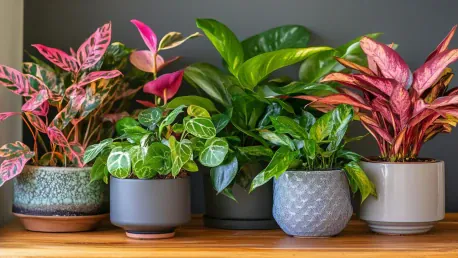Indoor plants have increasingly become a staple in home decor, not only for their beauty but for their health benefits. Integrating plants into interior spaces can provide an easy yet impactful way to enhance the aesthetic and well-being of a home. This growing trend toward incorporating greenery in living spaces not only boosts visual appeal but also contributes significantly to improving air quality and fostering a serene atmosphere.
Aesthetic Appeal and Health Benefits
The Snake Plant: Beauty and Purification in One
One of the top choices for indoor plant enthusiasts is the snake plant, also known as Dracaena trifasciata. This plant is admired for its striking, upright leaves that add a modern touch to any room’s decor. Its tall, architectural form makes it a popular choice for those seeking to add a contemporary feel to their interior design.
In addition to its looks, the snake plant is renowned for its air-purifying qualities. It is effective at removing toxins from the air and releasing oxygen, which can contribute to better indoor air quality and improved health. According to interior design expert Marie Flanigan, the snake plant excels in reducing pollutants such as formaldehyde and benzene, common in indoor environments. Its low maintenance and ability to thrive in low light conditions make it a versatile addition to various home areas, including bedrooms and offices.
The Versatile Spider Plant
Another favorite is the spider plant, easily recognizable by its slender, arching leaves. This plant’s vibrant green adds a lively element to the decor of any room, enhancing the visual appeal effortlessly. Interior designer Marie Flanigan praises its aesthetic versatility, which allows it to fit seamlessly into both minimalist and more eclectic decor styles.
The spider plant is robust and straightforward to care for, making it ideal for those new to plant care. Furthermore, it purifies the air and can propagate “spiderettes,” providing an interactive aspect to home gardening. Gardening writer Tenielle Jordison notes that the spider plant is particularly effective at removing carbon monoxide and xylene from indoor air. Its resilience and ease of care, combined with its ability to produce new “baby” plants, make it both a practical and charming choice for enhancing home environments.
Elegance and Serenity with the Peace Lily
The Peace Lily: Sophistication in Plant Form
The peace lily, or Spathiphyllum, is celebrated for its elegant teardrop-shaped flowers and lush green leaves. This plant imparts a sophisticated touch, elevating any room’s decor. Many design experts, including Marie Flanigan, appreciate the peace lily for its timeless beauty and its ability to create a serene atmosphere within living spaces.
Not only does the peace lily look beautiful, but it is also highly effective at improving air quality. It can thrive in various lighting conditions, though it performs best in bright light, which enhances its blooming potential. Gardening expert Tenielle Jordison emphasizes that the peace lily is particularly adept at removing pollutants like ammonia and trichloroethylene from the air. This adaptability, coupled with its aesthetic appeal, makes the peace lily a staple for those seeking to blend sophistication with functionality in their home decor.
Adaptability and Air Quality Enhancement
Adaptability is another crucial characteristic of the peace lily, making it suitable for diverse interior settings. Its ability to purify indoor air further contributes to a healthier living environment, aligning with contemporary design trends that prioritize well-being. Marie Flanigan and Tenielle Jordison agree that the peace lily’s capacity to thrive in low to moderate light makes it perfect for various indoor locations, from living rooms to bathrooms.
The peace lily’s air-purifying capabilities are grounded in its ability to absorb harmful chemicals through its leaves, then breaking them down and neutralizing them. This feature makes it an essential component for those aiming to enhance their home’s air quality. Combining its aesthetic charm with its impressive health benefits places the peace lily as a key player in modern interior design strategies.
The Transformative Effect of Greenery
Introducing Texture, Colors, and Patterns
Incorporating plants like the snake plant, spider plant, and peace lily can transform interior spaces by adding varied textures, colors, and patterns. This natural contrast enriches the overall visual appeal of a room. Marie Flanigan highlights how greenery can introduce a dynamic element to home decor, offering both a sense of tranquility and visual interest.
Plants also contribute to a fresher indoor atmosphere, improving air quality and providing health benefits. These dual advantages align with the modern emphasis on design solutions that enhance the well-being of inhabitants. Tenielle Jordison notes that integrating plants into home design not only enhances aesthetic appeal but also physically and psychologically benefits residents, fostering a more holistic living environment.
Connecting with Nature
Marie Flanigan’s approach to using plants in home decor encapsulates a growing trend toward biophilic design—connecting people with nature. This design philosophy emphasizes the importance of incorporating natural elements, like plants, into built environments to promote mental and physical health. Plants represent an accessible means of bringing natural elements into everyday living spaces, fostering harmony.
By championing the integration of plants, designers like Marie resonate with the broader philosophy that promoting a healthier living environment also involves nurturing psychological well-being through the presence of natural elements. Embracing this philosophy entails understanding that the presence of greenery not only beautifies a space but also cultivates a connection with nature, essential for modern living.
Summary of Key Takeaways
Indoor plants have become an essential element in home decor, loved not just for their aesthetic appeal but also for their health benefits. These green additions to interior spaces offer a simple yet impactful way to enhance both the look and feel of a home. This rising trend of incorporating greenery indoors not only elevates visual appeal but also plays a significant role in improving air quality. Plants can naturally purify the air by absorbing toxins and releasing oxygen, making the environment healthier. Moreover, they contribute to creating a calmer and more serene atmosphere, which can be especially beneficial in our increasingly hectic lives. Whether you live in a cramped apartment or a spacious house, adding indoor plants can transform your space into a peaceful retreat. They also have the added benefit of boosting your mood and productivity. In essence, the integration of indoor plants is a multifaceted approach that enhances beauty, promotes well-being, and reduces stress, making it a popular choice for modern interior design.









